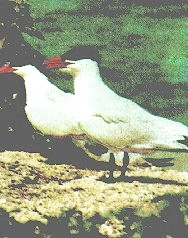 Synonyms: Sterna
caspia Pallas, 1770, Hydroprogne tschedrava Lep.
Synonyms: Sterna
caspia Pallas, 1770, Hydroprogne tschedrava Lep.Hydroprogne caspia (Pallas, 1770)
 Synonyms: Sterna
caspia Pallas, 1770, Hydroprogne tschedrava Lep.
Synonyms: Sterna
caspia Pallas, 1770, Hydroprogne tschedrava Lep.
Common names: Engl: Caspian Tern; Russ: Chegrava; Turk: Hazer sumrusu; Ukr: Chegrava.
Order (Scientific): CHARADRIIFORMES.
Family (Scientific): LARIDAE.
Taxonomic descriptions: Around 400-950 pairs.
 IUCN
Status:
IUCN
Status:
World level: LR
Black Sea Regional level: EN
Subregion level: EN
Distribution:
Habitats type, Critical habitats, Limiting factors: Mostly bare shell-covered areas of the accumulative islands in the brackish shallow waters and estuaries. Numbers are limited by human disturbance of the colonies and storms.
Biology: Breeding, migratory species. Arrival in early April. Fall egg-laying in late April - early May. Formed colonies were recorded between the 20th and 25th of May. In the post - breeding period birds either stay in the colony area or move eastwards and westwards. Migration to the wintering grounds takes place in September-October. At the end of October Caspian Terns already occur in the Mediterranean. Colonies of Caspian Terns are always situated away from other colonial birds and characterized by a high nesting density. Its nest is a flat shallow scrab in the shell substrate. The clutch size varies from 1 to 3 eggs. The egg-laying period is rather prolonged. If first clutches are lost, replacement ones are normally laid. Under favourable conditions breeding success is high. Exclusively ichtyophagous (sea and fresh-water fish). Forages up to 20 km from colony, quickly responds to the availability of mass food.
Population trends: Numbers are fluctuating. A general decline has been recorded. Only two out of four existing colonies are characterized by stable numbers and favourable breeding conditions. The numbers of Caspian Terns are critical and colonies are likely to disappear.
Threats: Disturbance and unfavourable weather conditions leading to overcrowding of the colonies.
Conservation measures taken: One of the two main colonies is protected in a reserve.
Conservation measures proposed: Obligatory protection of all breeding colonies.
References:
Compiled by: V.Siokhin.